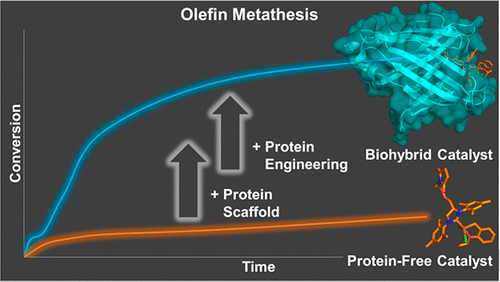当前位置:
X-MOL 学术
›
ACS Catal.
›
论文详情
Our official English website, www.x-mol.net, welcomes your
feedback! (Note: you will need to create a separate account there.)
Cavity Size Engineering of a β-Barrel Protein Generates Efficient Biohybrid Catalysts for Olefin Metathesis
ACS Catalysis ( IF 11.3 ) Pub Date : 2018-02-28 00:00:00 , DOI: 10.1021/acscatal.7b03652 Alexander R. Grimm 1 , Daniel F. Sauer 2 , Mehdi D. Davari 1 , Leilei Zhu 1 , Marco Bocola 1 , Shunsuke Kato 3 , Akira Onoda 3 , Takashi Hayashi 3 , Jun Okuda 2 , Ulrich Schwaneberg 1, 4
ACS Catalysis ( IF 11.3 ) Pub Date : 2018-02-28 00:00:00 , DOI: 10.1021/acscatal.7b03652 Alexander R. Grimm 1 , Daniel F. Sauer 2 , Mehdi D. Davari 1 , Leilei Zhu 1 , Marco Bocola 1 , Shunsuke Kato 3 , Akira Onoda 3 , Takashi Hayashi 3 , Jun Okuda 2 , Ulrich Schwaneberg 1, 4
Affiliation

|
Incorporation of a synthetic metal catalyst into a protein scaffold yields a biohybrid catalyst, with a remarkable performance in aqueous media and the broad reaction scope of organometallic catalysts. A major challenge for efficient catalysis is the design of the interface between the protein scaffold and the metal catalyst. Until now, protein scaffolds have primarily been engineered by exchanging individual amino acids to anchor metal catalysts and alter their immediate environment. Here, cavity size engineering of the β-barrel protein nitrobindin was performed by duplicating multiple β-strands to generate an expanded variant. The approach of cavity size engineering enabled covalent incorporation of bulky catalysts at excellent coupling efficiencies and yielded excellent conversions in olefin metathesis, including ring-closing metathesis, ring-opening metathesis polymerization, and cross metathesis (conversions up to 99% and turnover numbers up to 10000).
中文翻译:

β-桶蛋白的空穴大小工程可产生高效的烯烃复分解用生物杂化催化剂
将合成金属催化剂掺入蛋白质支架中可产生生物杂化催化剂,在水性介质中具有出色的性能,并且有机金属催化剂的反应范围广。有效催化的主要挑战是蛋白质支架与金属催化剂之间界面的设计。迄今为止,蛋白质支架主要是通过交换单个氨基酸来固定金属催化剂并改变其直接环境而进行工程设计的。在此,通过复制多个β链以生成扩展的变体来进行β桶蛋白nitrobindin的腔体大小工程设计。腔尺寸工程化的方法能够以优异的偶联效率共价引入大体积的催化剂,并在烯烃复分解(包括闭环复分解)中产生出色的转化率,
更新日期:2018-02-28
中文翻译:

β-桶蛋白的空穴大小工程可产生高效的烯烃复分解用生物杂化催化剂
将合成金属催化剂掺入蛋白质支架中可产生生物杂化催化剂,在水性介质中具有出色的性能,并且有机金属催化剂的反应范围广。有效催化的主要挑战是蛋白质支架与金属催化剂之间界面的设计。迄今为止,蛋白质支架主要是通过交换单个氨基酸来固定金属催化剂并改变其直接环境而进行工程设计的。在此,通过复制多个β链以生成扩展的变体来进行β桶蛋白nitrobindin的腔体大小工程设计。腔尺寸工程化的方法能够以优异的偶联效率共价引入大体积的催化剂,并在烯烃复分解(包括闭环复分解)中产生出色的转化率,











































 京公网安备 11010802027423号
京公网安备 11010802027423号